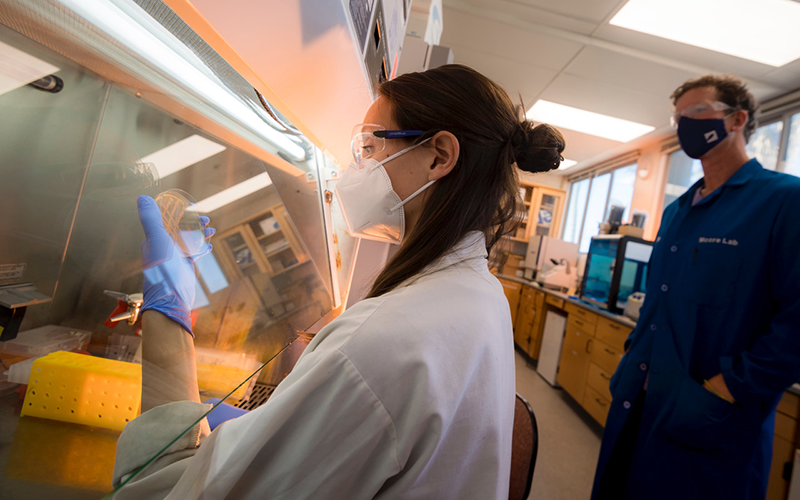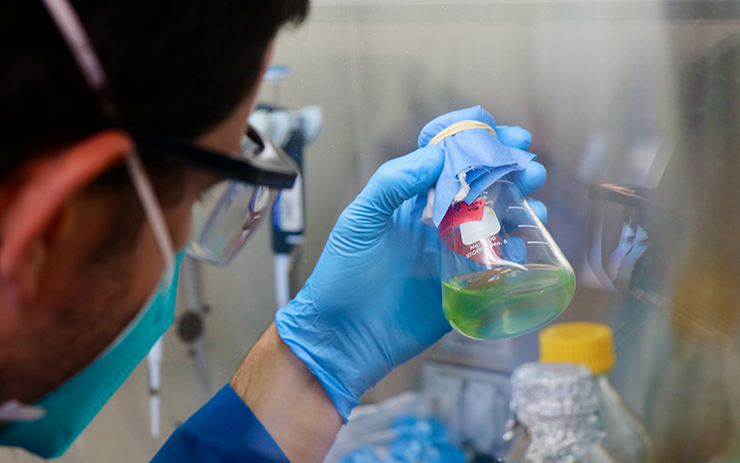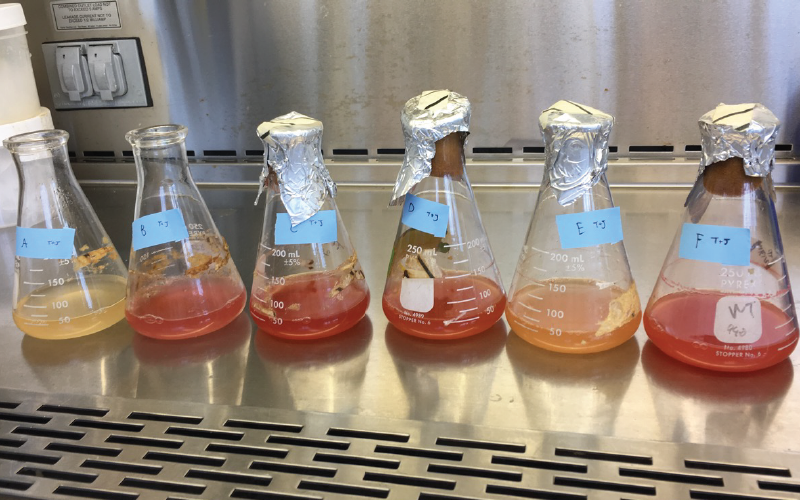BRADLEY MOORE
Professor
CTR FOR MARINE BIOTEC & BIOMED
Research Interests
- Marine Biomedicine and Biotechnology
- Microbial Genomics and Metabolomics
- Natural Product Drug Discovery
- Natural Toxins and Pollutants
- Synthetic Biology
Degrees
- B.S., University of Hawaii
- PhD, University of Washington
- Postdoc, University of Zurich
Recent Publications
9129767 IWNPIQDK 1 apa 5 date desc year Moore 265 https://bsmoore.scrippsprofiles.ucsd.edu/wp-content/plugins/zotpress/
%7B%22status%22%3A%22success%22%2C%22updateneeded%22%3Afalse%2C%22instance%22%3Afalse%2C%22meta%22%3A%7B%22request_last%22%3A0%2C%22request_next%22%3A0%2C%22used_cache%22%3Atrue%7D%2C%22data%22%3A%5B%7B%22key%22%3A%22ZXZZV8BU%22%2C%22library%22%3A%7B%22id%22%3A9129767%7D%2C%22meta%22%3A%7B%22creatorSummary%22%3A%22Bushin%20et%20al.%22%2C%22parsedDate%22%3A%222025-11-03%22%2C%22numChildren%22%3A0%7D%2C%22bib%22%3A%22%26lt%3Bdiv%20class%3D%26quot%3Bcsl-bib-body%26quot%3B%20style%3D%26quot%3Bline-height%3A%202%3B%20padding-left%3A%201em%3B%20text-indent%3A-1em%3B%26quot%3B%26gt%3B%5Cn%20%20%26lt%3Bdiv%20class%3D%26quot%3Bcsl-entry%26quot%3B%26gt%3BBushin%2C%20L.%20B.%2C%20Alter%2C%20T.%20B.%2C%20Alv%26%23xE1%3Bn-Vargas%2C%20M.%20V.%20G.%2C%20D%26%23xFC%3Brr%2C%20L.%2C%20Olson%2C%20E.%20C.%2C%20Avila%2C%20M.%20J.%2C%20Volke%2C%20D.%20C.%2C%20Puiggen%26%23xE9%3B%2C%20%26%23xD2%3B.%2C%20Kim%2C%20T.%2C%20Deravi%2C%20L.%20F.%2C%20Feist%2C%20A.%20M.%2C%20Nikel%2C%20P.%20I.%2C%20%26amp%3B%20%26lt%3Bstrong%26gt%3BMoore%26lt%3B%5C%2Fstrong%26gt%3B%2C%20B.%20S.%20%282025%29.%20Growth-coupled%20microbial%20biosynthesis%20of%20the%20animal%20pigment%20xanthommatin.%20%26lt%3Bi%26gt%3BNature%20Biotechnology%26lt%3B%5C%2Fi%26gt%3B.%20%26lt%3Ba%20class%3D%26%23039%3Bzp-DOIURL%26%23039%3B%20href%3D%26%23039%3Bhttps%3A%5C%2F%5C%2Fdoi.org%5C%2F10.1038%5C%2Fs41587-025-02867-7%26%23039%3B%26gt%3Bhttps%3A%5C%2F%5C%2Fdoi.org%5C%2F10.1038%5C%2Fs41587-025-02867-7%26lt%3B%5C%2Fa%26gt%3B%26lt%3B%5C%2Fdiv%26gt%3B%5Cn%26lt%3B%5C%2Fdiv%26gt%3B%22%2C%22data%22%3A%7B%22itemType%22%3A%22journalArticle%22%2C%22title%22%3A%22Growth-coupled%20microbial%20biosynthesis%20of%20the%20animal%20pigment%20xanthommatin%22%2C%22creators%22%3A%5B%7B%22creatorType%22%3A%22author%22%2C%22firstName%22%3A%22Leah%20B.%22%2C%22lastName%22%3A%22Bushin%22%7D%2C%7B%22creatorType%22%3A%22author%22%2C%22firstName%22%3A%22Tobias%20B.%22%2C%22lastName%22%3A%22Alter%22%7D%2C%7B%22creatorType%22%3A%22author%22%2C%22firstName%22%3A%22Mar%5Cu00eda%20V.%20G.%22%2C%22lastName%22%3A%22Alv%5Cu00e1n-Vargas%22%7D%2C%7B%22creatorType%22%3A%22author%22%2C%22firstName%22%3A%22Lara%22%2C%22lastName%22%3A%22D%5Cu00fcrr%22%7D%2C%7B%22creatorType%22%3A%22author%22%2C%22firstName%22%3A%22Elina%20C.%22%2C%22lastName%22%3A%22Olson%22%7D%2C%7B%22creatorType%22%3A%22author%22%2C%22firstName%22%3A%22Mariah%20J.%22%2C%22lastName%22%3A%22Avila%22%7D%2C%7B%22creatorType%22%3A%22author%22%2C%22firstName%22%3A%22Daniel%20C.%22%2C%22lastName%22%3A%22Volke%22%7D%2C%7B%22creatorType%22%3A%22author%22%2C%22firstName%22%3A%22%5Cu00d2scar%22%2C%22lastName%22%3A%22Puiggen%5Cu00e9%22%7D%2C%7B%22creatorType%22%3A%22author%22%2C%22firstName%22%3A%22Taehwan%22%2C%22lastName%22%3A%22Kim%22%7D%2C%7B%22creatorType%22%3A%22author%22%2C%22firstName%22%3A%22Leila%20F.%22%2C%22lastName%22%3A%22Deravi%22%7D%2C%7B%22creatorType%22%3A%22author%22%2C%22firstName%22%3A%22Adam%20M.%22%2C%22lastName%22%3A%22Feist%22%7D%2C%7B%22creatorType%22%3A%22author%22%2C%22firstName%22%3A%22Pablo%20I.%22%2C%22lastName%22%3A%22Nikel%22%7D%2C%7B%22creatorType%22%3A%22author%22%2C%22firstName%22%3A%22Bradley%20S.%22%2C%22lastName%22%3A%22Moore%22%7D%5D%2C%22abstractNote%22%3A%22%22%2C%22date%22%3A%222025-11-03%22%2C%22language%22%3A%22en%22%2C%22DOI%22%3A%2210.1038%5C%2Fs41587-025-02867-7%22%2C%22ISSN%22%3A%221087-0156%2C%201546-1696%22%2C%22url%22%3A%22https%3A%5C%2F%5C%2Fwww.nature.com%5C%2Farticles%5C%2Fs41587-025-02867-7%22%2C%22collections%22%3A%5B%22IWNPIQDK%22%5D%2C%22dateModified%22%3A%222025-12-05T18%3A05%3A07Z%22%7D%7D%2C%7B%22key%22%3A%22S5Y6NBDT%22%2C%22library%22%3A%7B%22id%22%3A9129767%7D%2C%22meta%22%3A%7B%22creatorSummary%22%3A%22Wood-Rocca%20et%20al.%22%2C%22parsedDate%22%3A%222025-10-30%22%2C%22numChildren%22%3A0%7D%2C%22bib%22%3A%22%26lt%3Bdiv%20class%3D%26quot%3Bcsl-bib-body%26quot%3B%20style%3D%26quot%3Bline-height%3A%202%3B%20padding-left%3A%201em%3B%20text-indent%3A-1em%3B%26quot%3B%26gt%3B%5Cn%20%20%26lt%3Bdiv%20class%3D%26quot%3Bcsl-entry%26quot%3B%26gt%3BWood-Rocca%2C%20S.%20M.%2C%20Allsing%2C%20N.%2C%20Ashida%2C%20Y.%2C%20Mochizuki%2C%20M.%2C%20%26lt%3Bstrong%26gt%3BMoore%26lt%3B%5C%2Fstrong%26gt%3B%2C%20M.%20L.%2C%20F%26%23xFC%3Bssy%2C%20Z.%2C%20Kotaki%2C%20Y.%2C%20Puilingi%2C%20C.%2C%20Maeno%2C%20Y.%2C%20Beattie%2C%20A.%20W.%2C%20Allen%2C%20A.%20E.%2C%20Yotsu-Yamashita%2C%20M.%2C%20Michael%2C%20T.%20P.%2C%20%26amp%3B%20%26lt%3Bstrong%26gt%3BMoore%26lt%3B%5C%2Fstrong%26gt%3B%2C%20B.%20S.%20%282025%29.%20Domoic%20acid%20biosynthesis%20and%20genome%20expansion%20in%20%26lt%3Bi%26gt%3BNitzschia%20navis-varingica%26lt%3B%5C%2Fi%26gt%3B.%20%26lt%3Bi%26gt%3BmBio%26lt%3B%5C%2Fi%26gt%3B%2C%20e02079-25.%20%26lt%3Ba%20class%3D%26%23039%3Bzp-DOIURL%26%23039%3B%20href%3D%26%23039%3Bhttps%3A%5C%2F%5C%2Fdoi.org%5C%2F10.1128%5C%2Fmbio.02079-25%26%23039%3B%26gt%3Bhttps%3A%5C%2F%5C%2Fdoi.org%5C%2F10.1128%5C%2Fmbio.02079-25%26lt%3B%5C%2Fa%26gt%3B%26lt%3B%5C%2Fdiv%26gt%3B%5Cn%26lt%3B%5C%2Fdiv%26gt%3B%22%2C%22data%22%3A%7B%22itemType%22%3A%22journalArticle%22%2C%22title%22%3A%22Domoic%20acid%20biosynthesis%20and%20genome%20expansion%20in%20%3Ci%3ENitzschia%20navis-varingica%3C%5C%2Fi%3E%22%2C%22creators%22%3A%5B%7B%22creatorType%22%3A%22author%22%2C%22firstName%22%3A%22Steffaney%20M.%22%2C%22lastName%22%3A%22Wood-Rocca%22%7D%2C%7B%22creatorType%22%3A%22author%22%2C%22firstName%22%3A%22Nicholas%22%2C%22lastName%22%3A%22Allsing%22%7D%2C%7B%22creatorType%22%3A%22author%22%2C%22firstName%22%3A%22Yasuhiro%22%2C%22lastName%22%3A%22Ashida%22%7D%2C%7B%22creatorType%22%3A%22author%22%2C%22firstName%22%3A%22Masaki%22%2C%22lastName%22%3A%22Mochizuki%22%7D%2C%7B%22creatorType%22%3A%22author%22%2C%22firstName%22%3A%22Malia%20L.%22%2C%22lastName%22%3A%22Moore%22%7D%2C%7B%22creatorType%22%3A%22author%22%2C%22firstName%22%3A%22Zolt%5Cu00e1n%22%2C%22lastName%22%3A%22F%5Cu00fcssy%22%7D%2C%7B%22creatorType%22%3A%22author%22%2C%22firstName%22%3A%22Yuichi%22%2C%22lastName%22%3A%22Kotaki%22%7D%2C%7B%22creatorType%22%3A%22author%22%2C%22firstName%22%3A%22Clyde%22%2C%22lastName%22%3A%22Puilingi%22%7D%2C%7B%22creatorType%22%3A%22author%22%2C%22firstName%22%3A%22Yukari%22%2C%22lastName%22%3A%22Maeno%22%7D%2C%7B%22creatorType%22%3A%22author%22%2C%22firstName%22%3A%22Aodhan%20W.%22%2C%22lastName%22%3A%22Beattie%22%7D%2C%7B%22creatorType%22%3A%22author%22%2C%22firstName%22%3A%22Andrew%20E.%22%2C%22lastName%22%3A%22Allen%22%7D%2C%7B%22creatorType%22%3A%22author%22%2C%22firstName%22%3A%22Mari%22%2C%22lastName%22%3A%22Yotsu-Yamashita%22%7D%2C%7B%22creatorType%22%3A%22author%22%2C%22firstName%22%3A%22Todd%20P.%22%2C%22lastName%22%3A%22Michael%22%7D%2C%7B%22creatorType%22%3A%22author%22%2C%22firstName%22%3A%22Bradley%20S.%22%2C%22lastName%22%3A%22Moore%22%7D%2C%7B%22creatorType%22%3A%22editor%22%2C%22firstName%22%3A%22Michael%20T.%22%2C%22lastName%22%3A%22Laub%22%7D%5D%2C%22abstractNote%22%3A%22ABSTRACT%5Cn%20%20%20%20%20%20%20%20%20%20%20%20%5Cn%20%20%20%20%20%20%20%20%20%20%20%20%20%20%5Cn%20%20%20%20%20%20%20%20%20%20%20%20%20%20%5Cn%20%20%20%20%20%20%20%20%20%20%20%20%20%20%20%20Production%20of%20the%20neurotoxin%20domoic%20acid%20%28DA%29%20by%20benthic%20diatom%5Cn%20%20%20%20%20%20%20%20%20%20%20%20%20%20%20%20Nitzschia%20navis-varingica%5Cn%20%20%20%20%20%20%20%20%20%20%20%20%20%20%20%20poses%20considerable%20health%20and%20economic%20concerns.%20In%20this%20study%2C%20we%20employed%20whole%20genome%20sequencing%20and%20transcriptomic%20analyses%20of%20regionally%20distinct%5Cn%20%20%20%20%20%20%20%20%20%20%20%20%20%20%20%20N.%20navis-varingica%5Cn%20%20%20%20%20%20%20%20%20%20%20%20%20%20%20%20strains%20to%20unravel%20the%20genomic%20underpinnings%20of%20DA%20biosynthesis.%20Our%20analyses%20revealed%20sizable%20genomes%5Cu2014characterized%20by%20an%20abundance%20of%20repetitive%20elements%20and%20noncoding%20DNA%5Cu2014that%20exceed%20the%20size%20of%20any%20other%20pennate%20diatoms.%20Central%20to%20our%20findings%20is%20the%20discovery%20of%20an%20expanded%20domoic%20acid%20biosynthesis%20%28%5Cn%20%20%20%20%20%20%20%20%20%20%20%20%20%20%20%20dab%5Cn%20%20%20%20%20%20%20%20%20%20%20%20%20%20%20%20%29%20gene%20cluster%2C%20spanning%20over%2060%20kb%20and%20marked%20by%20a%20unique%20organization%20that%20includes%20core%20genes%20interspersed%20with%20additional%20genetic%20elements.%20Phylogenetic%20and%20syntenic%20comparisons%20indicate%20that%20transposition%20events%20may%20have%20driven%20the%20expansion%20and%20reorganization%20of%20this%20cluster.%20Biochemical%20assays%20validated%20that%20the%20kainoid%20synthase%20encoded%20by%5Cn%20%20%20%20%20%20%20%20%20%20%20%20%20%20%20%20dabC%5Cn%20%20%20%20%20%20%20%20%20%20%20%20%20%20%20%20catalyzes%20the%20formation%20of%20isodomoic%20acid%20B%2C%20thereby%20establishing%20a%20distinct%20chemotype%20in%20contrast%20to%20the%20DA%20profiles%20of%20planktonic%20diatoms.%20These%20results%20highlight%20the%20evolutionary%20trajectory%20of%20DA%20biosynthesis%20in%20diatoms%20and%20potential%20advantages%20conferred%20by%20genome%20expansion%20and%20enzyme%20diversification%20in%20dynamic%20marine%20environments.%5Cn%20%20%20%20%20%20%20%20%20%20%20%20%20%20%5Cn%20%20%20%20%20%20%20%20%20%20%20%20%20%20%5Cn%20%20%20%20%20%20%20%20%20%20%20%20%20%20%20%20IMPORTANCE%5Cn%20%20%20%20%20%20%20%20%20%20%20%20%20%20%20%20%5Cn%20%20%20%20%20%20%20%20%20%20%20%20%20%20%20%20%20%20Domoic%20acid%20%28DA%29%20is%20a%20potent%20neurotoxin%20produced%20by%20marine%20micro-%20and%20macroalgae%20problematic%20to%20fisheries%20and%20toxic%20to%20humans%20and%20animals.%20Our%20study%20elucidates%20the%20molecular%20mechanisms%20underlying%20DA%20production%20in%20the%20widespread%20Western%20Pacific%20benthic%20diatom%2C%5Cn%20%20%20%20%20%20%20%20%20%20%20%20%20%20%20%20%20%20Nitzschia%20navis-varingica%5Cn%20%20%20%20%20%20%20%20%20%20%20%20%20%20%20%20%20%20.%20Genomic%20and%20biochemical%20insights%20add%20information%20to%20our%20understanding%20of%20the%20evolution%20of%20toxin%20production%20across%20diverse%20phyla%20and%20also%20fill%20a%20gap%20in%20the%20knowledge%20of%20secondary%20metabolism%20in%20marine%20diatoms.%20These%20findings%20provide%20a%20genetic%20framework%20for%20identifying%20toxin%20production%20and%20its%20impacts%20in%20the%20benthos%20of%20vulnerable%2C%20coastal%20ecosystems.%5Cn%20%20%20%20%20%20%20%20%20%20%20%20%20%20%20%20%5Cn%20%20%20%20%20%20%20%20%20%20%20%20%20%20%5Cn%20%20%20%20%20%20%20%20%20%20%20%20%5Cn%20%20%20%20%20%20%20%20%20%20%2C%20%5Cn%20%20%20%20%20%20%20%20%20%20%20%20%5Cn%20%20%20%20%20%20%20%20%20%20%20%20%20%20Domoic%20acid%20%28DA%29%20is%20a%20potent%20neurotoxin%20produced%20by%20marine%20micro-%20and%20macroalgae%20problematic%20to%20fisheries%20and%20toxic%20to%20humans%20and%20animals.%20Our%20study%20elucidates%20the%20molecular%20mechanisms%20underlying%20DA%20production%20in%20the%20widespread%20Western%20Pacific%20benthic%20diatom%2C%5Cn%20%20%20%20%20%20%20%20%20%20%20%20%20%20Nitzschia%20navis-varingica%5Cn%20%20%20%20%20%20%20%20%20%20%20%20%20%20.%20Genomic%20and%20biochemical%20insights%20add%20information%20to%20our%20understanding%20of%20the%20evolution%20of%20toxin%20production%20across%20diverse%20phyla%20and%20also%20fill%20a%20gap%20in%20the%20knowledge%20of%20secondary%20metabolism%20in%20marine%20diatoms.%20These%20findings%20provide%20a%20genetic%20framework%20for%20identifying%20toxin%20production%20and%20its%20impacts%20in%20the%20benthos%20of%20vulnerable%2C%20coastal%20ecosystems.%22%2C%22date%22%3A%222025-10-30%22%2C%22language%22%3A%22en%22%2C%22DOI%22%3A%2210.1128%5C%2Fmbio.02079-25%22%2C%22ISSN%22%3A%222150-7511%22%2C%22url%22%3A%22https%3A%5C%2F%5C%2Fjournals.asm.org%5C%2Fdoi%5C%2F10.1128%5C%2Fmbio.02079-25%22%2C%22collections%22%3A%5B%2286H9SNJB%22%2C%22IWNPIQDK%22%5D%2C%22dateModified%22%3A%222025-11-26T18%3A29%3A46Z%22%7D%7D%2C%7B%22key%22%3A%2245YQCXHZ%22%2C%22library%22%3A%7B%22id%22%3A9129767%7D%2C%22meta%22%3A%7B%22creatorSummary%22%3A%22Adak%20et%20al.%22%2C%22parsedDate%22%3A%222025-07-10%22%2C%22numChildren%22%3A0%7D%2C%22bib%22%3A%22%26lt%3Bdiv%20class%3D%26quot%3Bcsl-bib-body%26quot%3B%20style%3D%26quot%3Bline-height%3A%202%3B%20padding-left%3A%201em%3B%20text-indent%3A-1em%3B%26quot%3B%26gt%3B%5Cn%20%20%26lt%3Bdiv%20class%3D%26quot%3Bcsl-entry%26quot%3B%26gt%3BAdak%2C%20S.%2C%20Chase%2C%20A.%20B.%2C%20Skrip%2C%20A.%20E.%2C%20%26lt%3Bstrong%26gt%3BMoore%26lt%3B%5C%2Fstrong%26gt%3B%2C%20B.%20S.%2C%20%26amp%3B%20Lukowski%2C%20A.%20L.%20%282025%29.%20Metagenomic%20Identification%20of%20Brominated%20Indole%20Biosynthetic%20Machinery%20from%20Cyanobacteria.%20%26lt%3Bi%26gt%3BJournal%20of%20Natural%20Products%26lt%3B%5C%2Fi%26gt%3B.%20%26lt%3Ba%20class%3D%26%23039%3Bzp-DOIURL%26%23039%3B%20href%3D%26%23039%3Bhttps%3A%5C%2F%5C%2Fdoi.org%5C%2F10.1021%5C%2Facs.jnatprod.5c00492%26%23039%3B%26gt%3Bhttps%3A%5C%2F%5C%2Fdoi.org%5C%2F10.1021%5C%2Facs.jnatprod.5c00492%26lt%3B%5C%2Fa%26gt%3B%26lt%3B%5C%2Fdiv%26gt%3B%5Cn%26lt%3B%5C%2Fdiv%26gt%3B%22%2C%22data%22%3A%7B%22itemType%22%3A%22journalArticle%22%2C%22title%22%3A%22Metagenomic%20Identification%20of%20Brominated%20Indole%20Biosynthetic%20Machinery%20from%20Cyanobacteria%22%2C%22creators%22%3A%5B%7B%22creatorType%22%3A%22author%22%2C%22firstName%22%3A%22Sanjoy%22%2C%22lastName%22%3A%22Adak%22%7D%2C%7B%22creatorType%22%3A%22author%22%2C%22firstName%22%3A%22Alexander%20B.%22%2C%22lastName%22%3A%22Chase%22%7D%2C%7B%22creatorType%22%3A%22author%22%2C%22firstName%22%3A%22Anna%20E.%22%2C%22lastName%22%3A%22Skrip%22%7D%2C%7B%22creatorType%22%3A%22author%22%2C%22firstName%22%3A%22Bradley%20S.%22%2C%22lastName%22%3A%22Moore%22%7D%2C%7B%22creatorType%22%3A%22author%22%2C%22firstName%22%3A%22April%20L.%22%2C%22lastName%22%3A%22Lukowski%22%7D%5D%2C%22abstractNote%22%3A%22%22%2C%22date%22%3A%222025-07-10%22%2C%22language%22%3A%22en%22%2C%22DOI%22%3A%2210.1021%5C%2Facs.jnatprod.5c00492%22%2C%22ISSN%22%3A%220163-3864%2C%201520-6025%22%2C%22url%22%3A%22https%3A%5C%2F%5C%2Fpubs.acs.org%5C%2Fdoi%5C%2F10.1021%5C%2Facs.jnatprod.5c00492%22%2C%22collections%22%3A%5B%22IWNPIQDK%22%2C%22WK4TGLLK%22%5D%2C%22dateModified%22%3A%222025-07-22T20%3A36%3A41Z%22%7D%7D%2C%7B%22key%22%3A%22CH3QG6AS%22%2C%22library%22%3A%7B%22id%22%3A9129767%7D%2C%22meta%22%3A%7B%22creatorSummary%22%3A%22Moore%20and%20Newman%22%2C%22parsedDate%22%3A%222025-06-27%22%2C%22numChildren%22%3A0%7D%2C%22bib%22%3A%22%26lt%3Bdiv%20class%3D%26quot%3Bcsl-bib-body%26quot%3B%20style%3D%26quot%3Bline-height%3A%202%3B%20padding-left%3A%201em%3B%20text-indent%3A-1em%3B%26quot%3B%26gt%3B%5Cn%20%20%26lt%3Bdiv%20class%3D%26quot%3Bcsl-entry%26quot%3B%26gt%3B%26lt%3Bstrong%26gt%3BMoore%26lt%3B%5C%2Fstrong%26gt%3B%2C%20B.%20S.%2C%20%26amp%3B%20Newman%2C%20D.%20J.%20%282025%29.%20The%20Extraordinary%20Benefit%20of%20Nature%26%23x2019%3Bs%20Chemistry%20to%20Health%2C%20Society%2C%20and%20the%20Economy.%20%26lt%3Bi%26gt%3BJournal%20of%20Natural%20Products%26lt%3B%5C%2Fi%26gt%3B%2C%20%26lt%3Bi%26gt%3B88%26lt%3B%5C%2Fi%26gt%3B%286%29%2C%201541%26%23x2013%3B1548.%20%26lt%3Ba%20class%3D%26%23039%3Bzp-DOIURL%26%23039%3B%20href%3D%26%23039%3Bhttps%3A%5C%2F%5C%2Fdoi.org%5C%2F10.1021%5C%2Facs.jnatprod.5c00554%26%23039%3B%26gt%3Bhttps%3A%5C%2F%5C%2Fdoi.org%5C%2F10.1021%5C%2Facs.jnatprod.5c00554%26lt%3B%5C%2Fa%26gt%3B%26lt%3B%5C%2Fdiv%26gt%3B%5Cn%26lt%3B%5C%2Fdiv%26gt%3B%22%2C%22data%22%3A%7B%22itemType%22%3A%22journalArticle%22%2C%22title%22%3A%22The%20Extraordinary%20Benefit%20of%20Nature%5Cu2019s%20Chemistry%20to%20Health%2C%20Society%2C%20and%20the%20Economy%22%2C%22creators%22%3A%5B%7B%22creatorType%22%3A%22author%22%2C%22firstName%22%3A%22Bradley%20S.%22%2C%22lastName%22%3A%22Moore%22%7D%2C%7B%22creatorType%22%3A%22author%22%2C%22firstName%22%3A%22David%20J.%22%2C%22lastName%22%3A%22Newman%22%7D%5D%2C%22abstractNote%22%3A%22%22%2C%22date%22%3A%222025-06-27%22%2C%22language%22%3A%22en%22%2C%22DOI%22%3A%2210.1021%5C%2Facs.jnatprod.5c00554%22%2C%22ISSN%22%3A%220163-3864%2C%201520-6025%22%2C%22url%22%3A%22https%3A%5C%2F%5C%2Fpubs.acs.org%5C%2Fdoi%5C%2F10.1021%5C%2Facs.jnatprod.5c00554%22%2C%22collections%22%3A%5B%22IWNPIQDK%22%5D%2C%22dateModified%22%3A%222025-07-22T20%3A49%3A45Z%22%7D%7D%2C%7B%22key%22%3A%22NBW47BDL%22%2C%22library%22%3A%7B%22id%22%3A9129767%7D%2C%22meta%22%3A%7B%22creatorSummary%22%3A%22Grayson%20et%20al.%22%2C%22parsedDate%22%3A%222025-06-13%22%2C%22numChildren%22%3A0%7D%2C%22bib%22%3A%22%26lt%3Bdiv%20class%3D%26quot%3Bcsl-bib-body%26quot%3B%20style%3D%26quot%3Bline-height%3A%202%3B%20padding-left%3A%201em%3B%20text-indent%3A-1em%3B%26quot%3B%26gt%3B%5Cn%20%20%26lt%3Bdiv%20class%3D%26quot%3Bcsl-entry%26quot%3B%26gt%3BGrayson%2C%20N.%20E.%2C%20Scesa%2C%20P.%20D.%2C%20%26lt%3Bstrong%26gt%3BMoore%26lt%3B%5C%2Fstrong%26gt%3B%2C%20M.%20L.%2C%20Ledoux%2C%20J.-B.%2C%20Gomez-Garrido%2C%20J.%2C%20Alioto%2C%20T.%2C%20Michael%2C%20T.%20P.%2C%20Burkhardt%2C%20I.%2C%20Schmidt%2C%20E.%20W.%2C%20%26amp%3B%20%26lt%3Bstrong%26gt%3BMoore%26lt%3B%5C%2Fstrong%26gt%3B%2C%20B.%20S.%20%282025%29.%20A%20widespread%20metabolic%20gene%20cluster%20family%20in%20metazoans.%20%26lt%3Bi%26gt%3BNature%20Chemical%20Biology%26lt%3B%5C%2Fi%26gt%3B.%20%26lt%3Ba%20class%3D%26%23039%3Bzp-DOIURL%26%23039%3B%20href%3D%26%23039%3Bhttps%3A%5C%2F%5C%2Fdoi.org%5C%2F10.1038%5C%2Fs41589-025-01927-y%26%23039%3B%26gt%3Bhttps%3A%5C%2F%5C%2Fdoi.org%5C%2F10.1038%5C%2Fs41589-025-01927-y%26lt%3B%5C%2Fa%26gt%3B%26lt%3B%5C%2Fdiv%26gt%3B%5Cn%26lt%3B%5C%2Fdiv%26gt%3B%22%2C%22data%22%3A%7B%22itemType%22%3A%22journalArticle%22%2C%22title%22%3A%22A%20widespread%20metabolic%20gene%20cluster%20family%20in%20metazoans%22%2C%22creators%22%3A%5B%7B%22creatorType%22%3A%22author%22%2C%22firstName%22%3A%22Natalie%20E.%22%2C%22lastName%22%3A%22Grayson%22%7D%2C%7B%22creatorType%22%3A%22author%22%2C%22firstName%22%3A%22Paul%20D.%22%2C%22lastName%22%3A%22Scesa%22%7D%2C%7B%22creatorType%22%3A%22author%22%2C%22firstName%22%3A%22Malia%20L.%22%2C%22lastName%22%3A%22Moore%22%7D%2C%7B%22creatorType%22%3A%22author%22%2C%22firstName%22%3A%22Jean-Baptiste%22%2C%22lastName%22%3A%22Ledoux%22%7D%2C%7B%22creatorType%22%3A%22author%22%2C%22firstName%22%3A%22Jessica%22%2C%22lastName%22%3A%22Gomez-Garrido%22%7D%2C%7B%22creatorType%22%3A%22author%22%2C%22firstName%22%3A%22Tyler%22%2C%22lastName%22%3A%22Alioto%22%7D%2C%7B%22creatorType%22%3A%22author%22%2C%22firstName%22%3A%22Todd%20P.%22%2C%22lastName%22%3A%22Michael%22%7D%2C%7B%22creatorType%22%3A%22author%22%2C%22firstName%22%3A%22Immo%22%2C%22lastName%22%3A%22Burkhardt%22%7D%2C%7B%22creatorType%22%3A%22author%22%2C%22firstName%22%3A%22Eric%20W.%22%2C%22lastName%22%3A%22Schmidt%22%7D%2C%7B%22creatorType%22%3A%22author%22%2C%22firstName%22%3A%22Bradley%20S.%22%2C%22lastName%22%3A%22Moore%22%7D%5D%2C%22abstractNote%22%3A%22%22%2C%22date%22%3A%222025-06-13%22%2C%22language%22%3A%22en%22%2C%22DOI%22%3A%2210.1038%5C%2Fs41589-025-01927-y%22%2C%22ISSN%22%3A%221552-4450%2C%201552-4469%22%2C%22url%22%3A%22https%3A%5C%2F%5C%2Fwww.nature.com%5C%2Farticles%5C%2Fs41589-025-01927-y%22%2C%22collections%22%3A%5B%22IWNPIQDK%22%5D%2C%22dateModified%22%3A%222025-07-01T17%3A15%3A46Z%22%7D%7D%5D%7D
Bushin, L. B., Alter, T. B., Alván-Vargas, M. V. G., Dürr, L., Olson, E. C., Avila, M. J., Volke, D. C., Puiggené, Ò., Kim, T., Deravi, L. F., Feist, A. M., Nikel, P. I., & Moore, B. S. (2025). Growth-coupled microbial biosynthesis of the animal pigment xanthommatin. Nature Biotechnology. https://doi.org/10.1038/s41587-025-02867-7
Wood-Rocca, S. M., Allsing, N., Ashida, Y., Mochizuki, M., Moore, M. L., Füssy, Z., Kotaki, Y., Puilingi, C., Maeno, Y., Beattie, A. W., Allen, A. E., Yotsu-Yamashita, M., Michael, T. P., & Moore, B. S. (2025). Domoic acid biosynthesis and genome expansion in Nitzschia navis-varingica. mBio, e02079-25. https://doi.org/10.1128/mbio.02079-25
Adak, S., Chase, A. B., Skrip, A. E., Moore, B. S., & Lukowski, A. L. (2025). Metagenomic Identification of Brominated Indole Biosynthetic Machinery from Cyanobacteria. Journal of Natural Products. https://doi.org/10.1021/acs.jnatprod.5c00492
Moore, B. S., & Newman, D. J. (2025). The Extraordinary Benefit of Nature’s Chemistry to Health, Society, and the Economy. Journal of Natural Products, 88(6), 1541–1548. https://doi.org/10.1021/acs.jnatprod.5c00554
Grayson, N. E., Scesa, P. D., Moore, M. L., Ledoux, J.-B., Gomez-Garrido, J., Alioto, T., Michael, T. P., Burkhardt, I., Schmidt, E. W., & Moore, B. S. (2025). A widespread metabolic gene cluster family in metazoans. Nature Chemical Biology. https://doi.org/10.1038/s41589-025-01927-y



